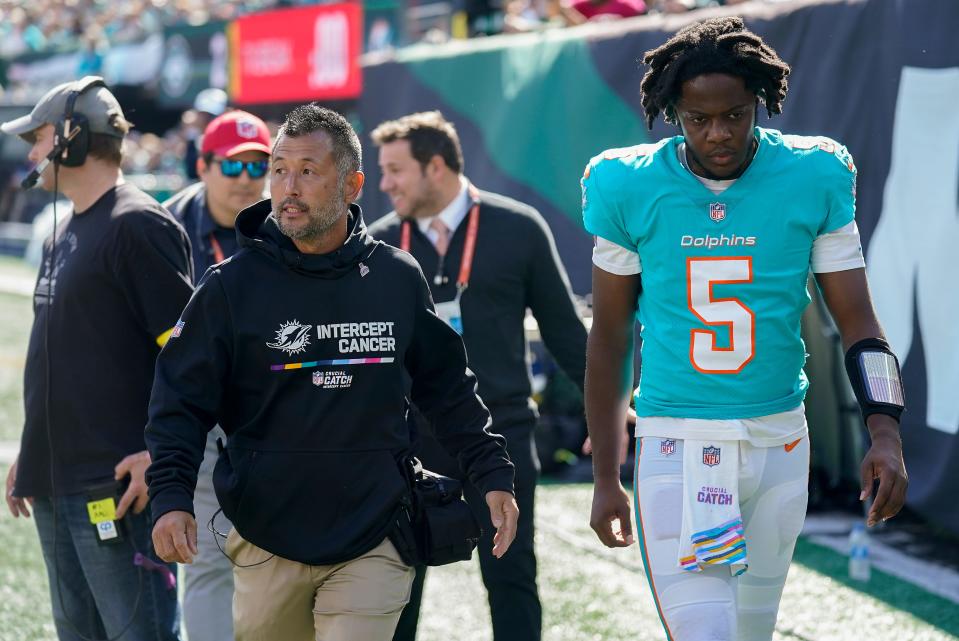What is ataxia? Here's what to know about NFL concussion protocol's new no-go symptom
The NFL and NFL Players Association added a new set of criteria a player must meet to return to play under its new concussion protocol, barring any player exhibiting signs of ataxia from re-entering a game.
The new protocols come in wake of the recent controversy surrounding Tua Tagovailoa when the Miami Dolphins quarterback was carted off the field and diagnosed with a concussion in a Thursday night game against the Cincinnati Bengals, just days after he appeared to suffer a head injury in a Week 3 win against the Buffalo Bills, only for the team to say it was a back injury.
"The Protocol exists to establish a high standard of concussion care for each player whereby every medical professional engages in a meaningful and rigorous examination of the player-patent (sic)," the NFL and NFLPA said in a statement.
The change in protocols includes the term "ataxia" as a no-go symptom for players, and the updated regulations were put into effect starting with Week 5's Sunday games.
But what is ataxia? What are its symptoms? Here is what to know:

Opinion: Teddy Bridgewater case shows NFL's concussion protocols need more tweaking
Opinion: NFL culture getting another wake-up call on concussions following Joe Burrow's comments
More: Former NFL head coach Rex Ryan calls Tua Tagovailoa’s concussion evaluation an 'epic fail'
What is ataxia?
Ataxia is a term that literally means "without coordination," according to Johns Hopkins Medicine.
The Mayo Clinic adds it results from "damage to the part of the brain that controls muscle coordination (cerebellum) or its connections."
It can be caused by things such as alcohol misuse, stroke, tumors, multiple sclerosis, genetic disorders or certain medications, according to the Mayo Clinic. In cases involving head trauma, the Mayo Clinic says severe brain damage can cause the brain disorder to last weeks to months after the trauma.
Worst cases of ataxia can lead to death, Johns Hopkins Medicine says.
While it is a neurological disease, it can also be used as a symptom of incoordination as a result of injury and neurological issue, the National Ataxia Foundation says, which is how the NFL views ataxia.
What are ataxia symptoms?
The National Ataxia Foundation says ataxia symptoms are similar to being drunk, in that people have problems using their extremities, as well as talking or moving their eyes. These are the most common symptoms of ataxia, according to multiple health agencies:
Lack of or poor coordination
Difficulty walking
Poor balance
Slurred speech
Difficulty with fine motor tasks like eating or writing
Abnormalities in eye movements
Tremors
Pain and fatigue
Health experts say people should seek medical attention if they have balance issues, lose muscle coordination in hands, arms or legs, as well as slurred speech and difficulty eating.
'Life is so precious': Tyreek Hill on Dolphins quarterback Tua Tagovailoa's concussion
Bills-Steelers: Bills' A.J. Epenesa ejected for elbowing referee; Steelers' Kenny Pickett says he was hit in knee
How are ataxia symptoms being used by the NFL?
The NFL and NFLPA said if a player shows signs of ataxia, they are prohibited from returning to a game.
The updated concussion protocols were used early in Sunday's slate of games; Teddy Bridgewater, who started at quarterback for the Dolphins in place of Tagovailoa, took a hit from New York Jets defensive back Sauce Gardner on Miami's first offensive play.
Bridgewater left the field and was escorted into a medical tent, considered questionable to return as he was evaluated for a head injury. Later, it was reported Bridgewater passed his concussion tests, but the spotter saw the quarterback experiencing ataxia, ruling him out for the rest of the game.
New Orleans Saints rookie receiver Chris Olave was also taken out of action Sunday, missing the rest of the team's win against the Seattle Seahawks after appearing to hit his head on the ground while coming down from catching a touchdown pass. He was ruled out with a concussion.
Both players will be put into concussion protocol and must pass those steps before being allowed to play.
Contributing: Safid Deen, USA TODAY; Eric J. Wallace, Palm Beach Post
Follow Jordan Mendoza on Twitter: @jordan_mendoza5.
This article originally appeared on USA TODAY: Ataxia: What is ataxia, symptoms after NFL concussion update

